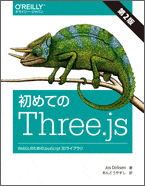はじめに
three.jsを学ぶため、
オライリー本「初めてのThree.js」をまとめることで内容を咀嚼していこう思う。
今回は第一章の途中まで。
初めてのThree.js 第2版
――WebGLのためのJavaScript 3Dライブラリ
github learning-three-js-2e-ja-support
はじめのまとめ
- HTMLスケルトンの作成
- code sample
- カメラ ライト 描画したいオブジェクトを追加
HTMLスケルトンの作成
Three.jsを出力する空のスケルトンHTMLを作成
(*Three.jsはサーバー環境でないと動きません。)
index.html
<!DOCTYPE html>
<html>
<head>
<title>Example 01.01 - Basic skeleton</title>
<script type="text/javascript" src="../libs/three.js"></script>
<style>
body {
/* set margin to 0 and overflow to hidden, to
use the complete page */
margin: 0;
overflow: hidden;
}
</style>
</head>
<body>
<!-- Div which will hold the Output -->
<div id="WebGL-output">
</div>
<!-- Javascript code that runs our Three.js examples -->
<script type="text/javascript">
// once everything is loaded, we run our Three.js stuff.
function init() {
// here we'll put the Three.js stuff
}
window.onload = init;
</script>
</body>
</html>
-
<head>要素内でThree.jsをロード(CDNはこちら) - styleでスクロールバー除去
-
<div id="WebGL-output">でThree.jsレンダラーの出力を表示、保持する -
window.onload = init;でjsを呼び出す
code sample
index.html
<script type="text/javascript">
// once everything is loaded, we run our Three.js stuff.
function init() {
// create a scene, that will hold all our elements such as objects, cameras and lights.
var scene = new THREE.Scene();
// create a camera, which defines where we're looking at.
var camera = new THREE.PerspectiveCamera(45, window.innerWidth / window.innerHeight, 0.1, 1000);
// create a render and set the size
var renderer = new THREE.WebGLRenderer();
renderer.setClearColor(new THREE.Color(0xEEEEEE));
renderer.setSize(window.innerWidth, window.innerHeight);
// show axes in the screen
var axes = new THREE.AxisHelper(20);
scene.add(axes);
// create the ground plane
var planeGeometry = new THREE.PlaneGeometry(60, 20);
var planeMaterial = new THREE.MeshBasicMaterial({color: 0xcccccc});
var plane = new THREE.Mesh(planeGeometry, planeMaterial);
// rotate and position the plane
plane.rotation.x = -0.5 * Math.PI;
plane.position.x = 15;
plane.position.y = 0;
plane.position.z = 0;
// add the plane to the scene
scene.add(plane);
// create a cube
var cubeGeometry = new THREE.BoxGeometry(4, 4, 4);
var cubeMaterial = new THREE.MeshBasicMaterial({color: 0xff0000, wireframe: true});
var cube = new THREE.Mesh(cubeGeometry, cubeMaterial);
// position the cube
cube.position.x = -4;
cube.position.y = 3;
cube.position.z = 0;
// add the cube to the scene
scene.add(cube);
// create a sphere
var sphereGeometry = new THREE.SphereGeometry(4, 20, 20);
var sphereMaterial = new THREE.MeshBasicMaterial({color: 0x7777ff, wireframe: true});
var sphere = new THREE.Mesh(sphereGeometry, sphereMaterial);
// position the sphere
sphere.position.x = 20;
sphere.position.y = 4;
sphere.position.z = 2;
// add the sphere to the scene
scene.add(sphere);
// position and point the camera to the center of the scene
camera.position.x = -30;
camera.position.y = 40;
camera.position.z = 30;
camera.lookAt(scene.position);
// add the output of the renderer to the html element
document.getElementById("WebGL-output").appendChild(renderer.domElement);
// render the scene
renderer.render(scene, camera);
}
window.onload = init;
</script>
以下、部分解説
scene camera renderer を定義する
three.js
// create a scene, that will hold all our elements such as objects, cameras and lights.
var scene = new THREE.Scene();
// create a camera, which defines where we're looking at.
var camera = new THREE.PerspectiveCamera(45, window.innerWidth / window.innerHeight, 0.1, 1000);
// create a render and set the size
var renderer = new THREE.WebGLRenderer();
renderer.setClearColor(new THREE.Color(0xEEEEEE));
renderer.setSize(window.innerWidth, window.innerHeight);
- scene オブジェクト
表示したいすべての物体光源を保持して変更を監視するコンテナオブジェクト - camera オブジェクト
シーンを描画する時に何が見えるか決定する - renderer オブジェクト
cameraオブジェクトの角度に基づいてブラウザ内でsceneオブジェクトがどのように見えるのか計算する
ここではTHREE.WebGLRenderer()をつかって描画
setClearColor関数を使って色を設定
setSize関数で描画するシーンの大きさをrendererに通知
座標と平面を追加する
three.js
// show axes in the screen
var axes = new THREE.AxisHelper(20);
scene.add(axes);
// create the ground plane
var planeGeometry = new THREE.PlaneGeometry(60, 20);
var planeMaterial = new THREE.MeshBasicMaterial({color: 0xcccccc});
var plane = new THREE.Mesh(planeGeometry, planeMaterial);
// rotate and position the plane
plane.rotation.x = -0.5 * Math.PI;
plane.position.x = 15;
plane.position.y = 0;
plane.position.z = 0;
// add the plane to the scene
scene.add(plane);
- 座標軸
axesオブジェクトを作成してscene.add関数でシーンに追加する - 平面
平面を追加するにはどのような平面(幅、高さ)であるか、なに色であるか設定する必要がある(planeGeometry planeMaterialで定義)
これら二つを組み合わせてTHREE.Meshでplaneというオブジェクトを作成
次に配置を決める
rotation.xで平面を90度傾ける
x y z の位置を決めてscene.add(plane)でシーンに追加する
カメラの位置を設定する
three.js
// position and point the camera to the center of the scene
camera.position.x = -30;
camera.position.y = 40;
camera.position.z = 30;
camera.lookAt(scene.position);
// add the output of the renderer to the html element
document.getElementById("WebGL-output").appendChild(renderer.domElement);
// render the scene
renderer.render(scene, camera);
position.x position.y position.z を使って位置を設定する
camera.lookAt(scene.position);でlookAt関数を使ってシーンの中心を向くように指定(デフォルトで(0,0,0)に位置)
あとはjsのappendChild関数でdiv要素に追加
最後にrendererに描画の指示をする。
今回はここまで。
次はマテリアル、ライト、影の追加の部分について書きます。
